radiator cap OLDSMOBILE SILHOUETTE 1997 Owners Manual
[x] Cancel search | Manufacturer: OLDSMOBILE, Model Year: 1997, Model line: SILHOUETTE, Model: OLDSMOBILE SILHOUETTE 1997Pages: 436, PDF Size: 21.87 MB
Page 279 of 436
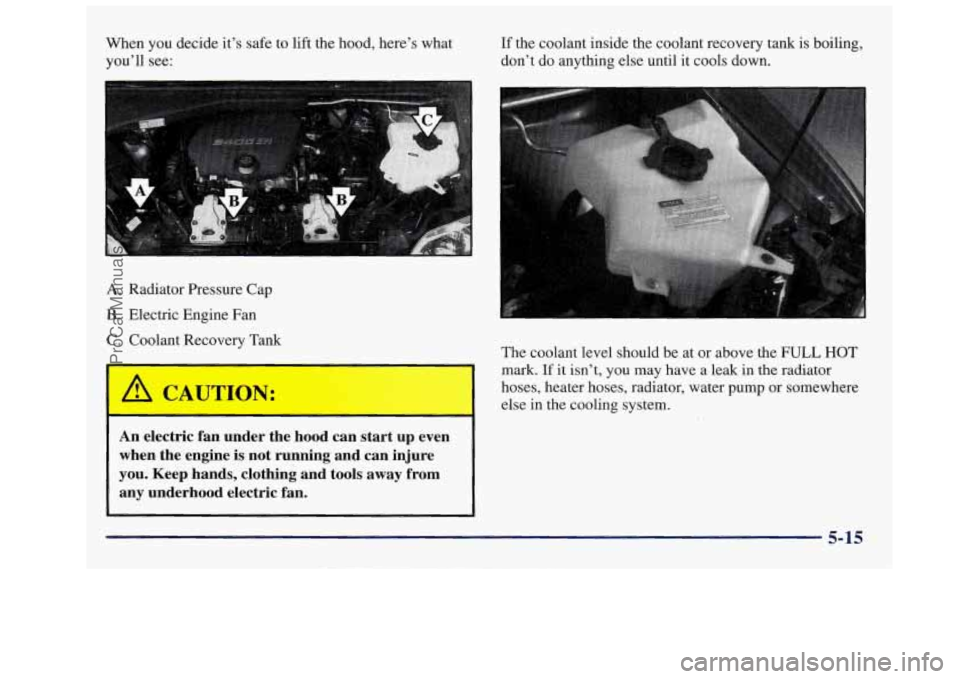
When you decide it’s safe to lift the hood, here’s what
you’ll see:
A. Radiator Pressure Cap
B. Electric Engine Fan
C. Coolant Recovery Tank If
the coolant inside the coolant recovery tank is boiling,
don’t do anything else until it cools down.
The coolant level should be at or above the
FULL HOT
mark.
If it isn’t, you may have a leak in the radiator
hoses, heater hoses, radiator, water pump or somewhere else in the cooling system.
An electric fan under the hood can start up even
when the engine
is not running and can injure
you. Keep hands, clothing and tools away from any underhood electric fan.
5-15
ProCarManuals.com
Page 282 of 436

Steam and scalding liquids from a hot cooling
system can blow out and burn you badly. They
are under pressure, and if you turn the radiator
pressure cap
-- even a little -- they can come out
at high speed. Never turn the cap when the
cooling system, including the radiator pressure
cap, is hot. Wait for the cooling system and the
radiator pressure cap to cool
if you ever have to
turn the pressure cap.
5-18
ProCarManuals.com
Page 283 of 436
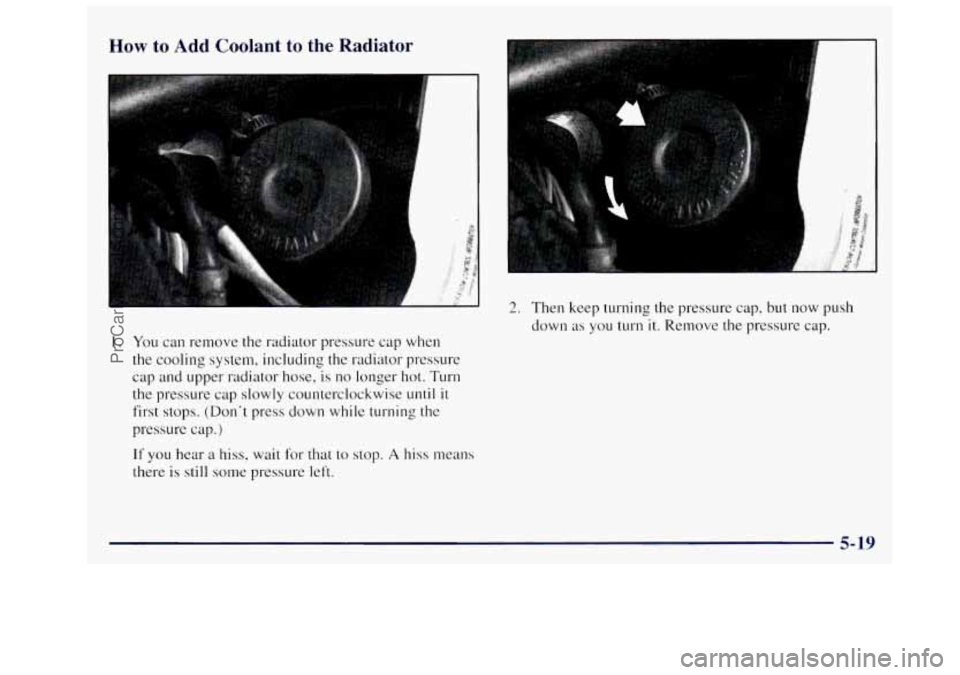
How to Add Coolant to the Radiator
1. You can remove the radiator pressure cap when
the cooling system, including the radiator pressure
cap and upper radiator hose, is no longer hot. Turn
the pressure cap slowly counterclockwise
until it
first stops. (Don’t press down while turning the
pressure cap.)
If you hear a hiss, wait for that to stop. A hiss means
there
is still some pressure left.
2. Then keep turning the pressure cap, but now push
down
as you turn it. Remove the pressure cap.
5-19
ProCarManuals.com
Page 284 of 436

3. Fill the radiator with the proper DEX-COOL" mix,
up to the base of the filler neck.
4. Then fill the coolant recovery tank to the FULL
HOT mark.
5. Put the cap back on the coolant recovery tank, but
leave the radiator pressure cap
off.
5-20
ProCarManuals.com
Page 285 of 436

6. Start the eng~ne and let it run until you can feel the
upper radiator hose getting hot. Watch out for the
engine fans.
7. By this time, the coolant level inside the radiator
filler neck may be lower.
If the level is lower, add
more of the proper
DEX-COOL" coolant mixture
through the filler neck until the level reaches the
base of the filler neck.
8. Then replace the pressure cap. At any time during
this procedure
if coolant begins to flow out of the
filler neck, reinstall the pressure cap. Be sure the
arrows on
the pressure cap line up like this.
5-21
ProCarManuals.com
Page 307 of 436
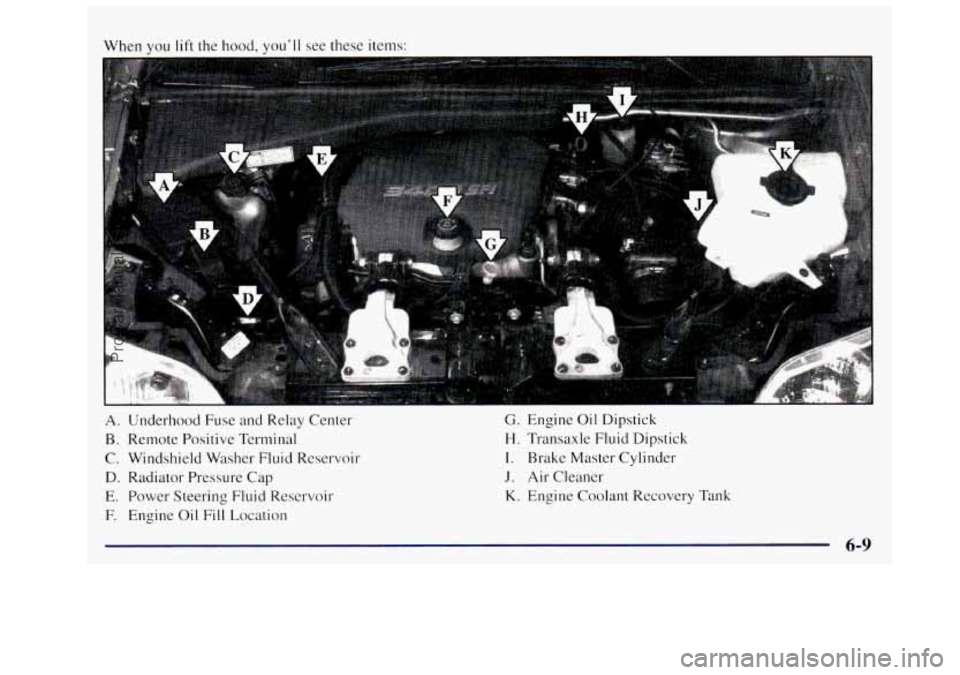
Nhen you lift the hood, you’ll see these items:
A. Underhood Fuse and Relay Center
B. Remote Positive Terminal
C. Windshield Washer Fluid Reservoir
D. Radiator Pressure Cap
E. Power Steering Fluid Reservoir
F. Engine Oil Fill Location
G. Engine Oil Dipstick
H. Transaxle Fluid Dipstick
I. Brake Master Cylinder
J. Air Cleancr
K. Engine Coolant Recovery Tank
6-9
ProCarManuals.com
Page 321 of 436
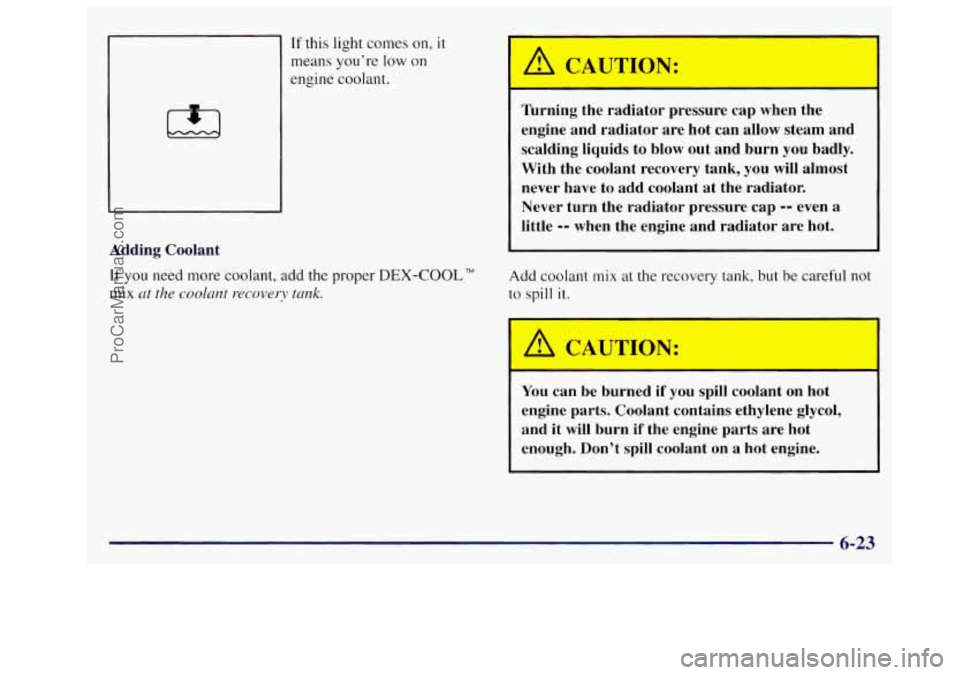
If this light comes on, it
means you're low on
Adding Coolant
If you need more coolant, add the proper DEX-COOL"
mix ut the coolant recovery tmk.
A CAUTION:
Turning the radiator pressure cap when the
engine and radiator are hot can allow steam and
scalding liquids to blow out and burn
you badly.
With the coolant recovery tank, you will almost
never have to add coolant at the radiator. Never turn the radiator pressure cap
-- even a
little
-- when the engine and radiator are hot.
Add coolant
mix at the recovery tank, but be careful not
to spill
it.
I A CAUTION:
You can be burned if you spill coolant on hot
engine parts. Coolant contains ethylene glycol,
and it will burn if the engine parts are hot
enough. Don't spill coolant on
a hot engine.
6-23
ProCarManuals.com
Page 322 of 436

Radiator Pressure Cap Power Steering Fluid
NOTICE:
Your
radiator cap is a 15 psi (105 kPa)
pressure-type cap and must be tightly installed to
prevent coolant
loss and possible engine damage
from overheating. Be sure the arrows on the cap
line up with the overflow tube on the radiator
filler neck.
When you replace your radiator pressure cap, an AC@
cap is recommended.
Thermostat
Engine coolant temperature is controlled by a thermostat
in the engine coolant system. The thermostat stops the
flow
of coolant through the radiator until the coolant
reaches a preset temperature.
When you replace your thermostat, an
AC@ thermostat
is recommended. The power steering fluid reservoir
is located
to the right
of the windshield washer fluid reservoir, at the back of
the engine compartment.
ProCarManuals.com
Page 324 of 436
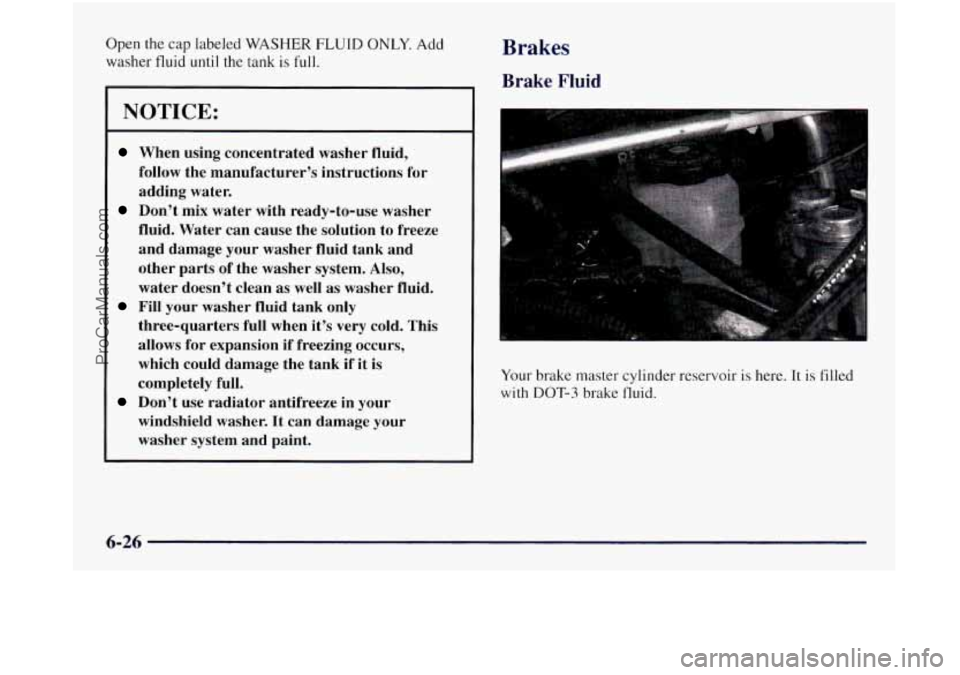
Open the cap labeled WASHER FLUID ONLY. Add
washer fluid
until the tank is full.
NOTICE:
When using concentrated washer fluid,
follow the manufacturer’s instructions for
adding water.
Don’t mix water with ready-to-use washer
fluid. Water can cause the solution to freeze
and damage your washer fluid tank and
other parts
of the washer system. Also,
water doesn’t clean
as well as washer fluid.
three-quarters full when it’s very cold. This
allows for expansion if freezing occurs,
which could damage the tank if it is
completely full.
windshield washer.
It can damage your
washer system and paint.
Fill your washer fluid tank only
Don’t use radiator antifreeze in your
Brakes
Brake Fluid
Your brake master cylinder reservoir is here. It is filled
with DOT-3 brake fluid.
6-26
ProCarManuals.com
Page 388 of 436
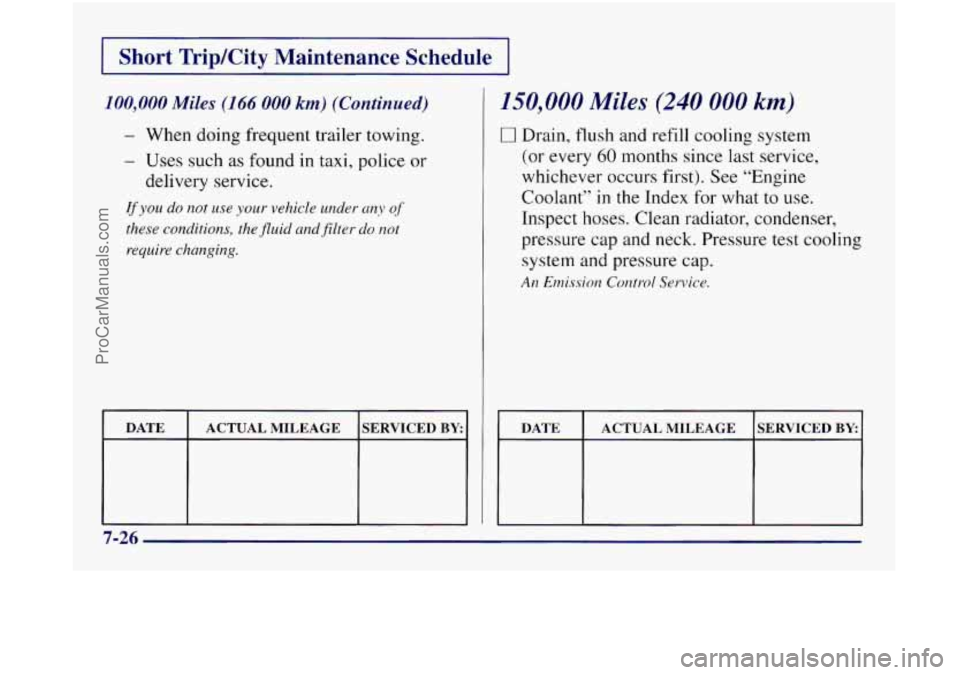
I Short TripKity Maintenance Schedule I
100,000 Miles (I 66 000 km) (Continued)
- When doing frequent trailer towing.
- Uses such as found in taxi, police or
lf you do not use your vehicle under my of
these conditions, the fluid and jilter do not
require changing.
delivery service.
DATE
ACTUAL MILEAGE
1
150,000 Miles (240 000 km)
0 Drain, flush and refill cooling system
(or every 60 months since last service,
whichever occurs first). See “Engine
Coolant”
in the Index for what to use.
Inspect hoses. Clean radiator, condenser,
pressure cap and neck. Pressure test cooling
system and pressure cap.
An Elnission Control Service.
I 1
DATE ACTUAL MILEAGE
7-26
ProCarManuals.com